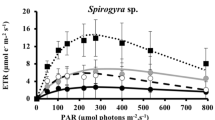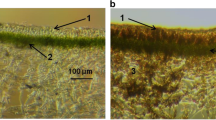Abstract
Photosynthetic activity of the moss Sanionia uncinata (Hedw.) Loeske was investigated on Léonie Island (67°35'S, 68°20'W, Antarctic Peninsula) in response to short-term changes of UV-B radiation. The UV-environment of natural mat formations dominated by S. uncinata was altered using filter screens. Two filter experiments were conducted in the Antarctic summers 1998 and 1999. A third filter experiment was conducted during springtime ozone depletion in October 1998. Photosynthetic activity of S. uncinata was mainly determined by photosynthetically active photon flux density (PPFD). Light response of relative electron transport rate through photosystem II (rel ETR=ΔF/Fm'×PPFD) remained unaffected by ambient summer levels of UV-B radiation. The same was found for net photosynthesis and dark respiration. In October 1998, S. uncinata was mainly metabolically inactive due to low temperatures. No significant levels of DNA-damage measured as cyclobutane pyrimidine dimers (CPDs) were induced by ambient summer levels of UV-B. Artificially enhanced UV-B radiation supplying a Setlow-DNA-dose of 8.7 kJ m−2 day−1 UV-B led to formation of 7±3 CPD (106 nucleotides)–1. It is concluded that current ambient summer levels of UV-B radiation do not affect photosynthetic activity in S. uncinata.






Similar content being viewed by others
References
Allen DJ, Nogués S, Baker NR (1998) Ozone depletion and increased UV-B radiation: is there a real threat to photosynthesis? J Exp Bot 49:1775–1788
Ballare CL, Rousseaux MC, Searles PS, Zaller JG, Giordano CV, Robson TM, Caldwell MM, Sala OE, Scopel AL (2001) Impacts of solar ultraviolet-B radiation on terrestrial ecosystems of Tierra del Fuego (southern Argentina)—an overview of recent progress. J Photochem Photobiol B Biol 62:67–77
Björn LO, Callaghan TV, Gehrke C, Gwynn-Jones D, Lee JA, Johanson U, Sonesson M, Buck ND (1999) Effects of ozone depletion and increased ultraviolet-B radiation on northern vegetation. Polar Res 18:331–337
Boelen P, Boer MKde, Kraay GW, Veldhuis MJW, Buma AGJ (2000) UVBR-induced DNA damage in natural marine picoplankton assemblages in the tropical Atlantic Ocean. Mar Ecol Prog Ser 193:1–9
Buma AGJ, Boer MKde, Boelen P (2001) Depth distributions of DNA damage in Antarctic marine phyto- and bacterioplankton exposed to summertime ultraviolet radiation. J Phycol 37:200–208
Caldwell MM (1971) Solar ultraviolet radiation and the growth and development of higher plants. In: Giese AC (ed) Photophysiology, vol 6. Academic Press, New York, pp 133–177
Convey P, Smith RIL (1997) The terrestrial arthropod fauna and its habitats in northern Marguerite Bay and Alexander Island, maritime Antarctic. Antarct Sci 9:12–26
Davey MC (1997) Effects of continuous ad repeated dehydration on carbon fixation by bryophytes from the maritime Antarctic. Oecologia 110:25–31
Day TA, Ruhland CT, Grobe CW, Xiong F (1999) Growth and reproduction of Antarctic vascular plants in response to warming and UV radiation reductions in the field. Oecologia 119:24–35
Farman JC, Gardiner BG, Shanklin JD (1985) Large losses of total ozone in Antarctica reveal seasonal CLOx/NOx interaction. Nature 315:207–210
Fowbert JA (1996) An experimental study of growth in relation to morphology and shoot water content in maritime Antarctic mosses. New Phytol 133:363–373
Gehrke C (1998) Effects of enhanced UV-B radiation on production-related properties of a Sphagnum fuscum dominated subarctic bog. Funct Ecol 12:940–947
Gehrke C (1999) Impacts of enhanced ultraviolet-B radiation on mosses in a subarctic heath ecosystem. Ecology 80:1844–1851
Gehrke C, Johanson U, Gwynn-Jones D, Björn LO, Callaghan TV, Lee JA (1996) Effects of enhanced ultraviolet-B radiation on terrestrial subarctic ecosystems and implications for interactions with increased atmospheric CO2. Ecol Bull 45:192–203
Green TGA, Schroeter B, Sancho LG (1999) Plant life in Antarctica. In: Pugnaire FI, Valladares F (eds) Handbook of functional plant ecology. Dekker, New York, pp 495–543
Green TGA, Schroeter B, Seppelt R (2000) Effect of temperature, light and ambient UV on the photosynthesis of the moss Bryum argenteum Hedw. in continental Antarctica. In: Davison W, Howard-Williams C, Broady P (eds) Antarctic ecosystems: models for wider understanding. Caxton Press, Christchurch, pp 165–170
Gwynn-Jones D, Lee JA, Johanson U, Phoenix GK, Callaghan TV, Sonnesson M (1999) The responses of plant functional types to enhanced UV-B radiation. In: Rozema J (ed) Stratospheric ozone depletion; the effects of enhanced UV-B radiation on terrestrial ecosystem. Backhuys, Leiden, pp 173–185
Huiskes AHL, Lud D, Moerdijk-Poortvliet TCW, Rozema J (1999) Impact of UV-B radiation on Antarctic terrestrial vegetation. In: Rozema J (ed) Stratospheric ozone depletion, the effects of enhanced UV-B radiation on terrestrial ecosystem. Backhuys, Leiden, pp 313–337
Jones AE, Shanklin JD (1995) Continued decline of total ozone over Halley, Antarctica, since 1985. Nature 376:409–411
Kenrick P, Crane PR (1997) The origin and early evolution of plants on land. Nature 389:33–39
Lud D, Buma AGJ, Poll Wvan de, Moerdijk TCW, Huiskes AHL (2001) DNA damage and photosynthetic performance in the Antarctic terrestrial alga Prasiola crispa ssp. antarctica (Chlorophyta) under manipulated UV-B radiation. J Phycol 37:459–467
Madronich S, McKenzie RL, Caldwell M, Björn LO (1998) Changes in biologically active ultraviolet radiation reaching the earth's surface. J Photochem Photobiol 46:5–19
Montiel P, Smith A, Keiller D (1999) Photosynthetic responses of selected Antarctic plants to solar radiation in the southern maritime Antarctic. Polar Res 18:229–235
Pakker H, Martins RST, Boelen P, Buma AGJ, Nikaido O, Breeman AM (2000) Effects of temperature on the photoreactivation of ultraviolet-B induced DNA damage in Palmaria palmata (Rhodophyta). J Phycol 36:334–341
Rousseaux MC, Ballare CL, Giordano CV, Scopel AL, Zima AM, Szwarcberg-Bracchitta M, Searles PS, Caldwell MM, Diaz SB (1999) Ozone depletion and UVB radiation: impact on plant DNA damage in southern South America. Proc Natl Acad Sci USA 96:15310–15315
Rousseaux MC, Scopel AL, Searles PS, Caldwell MM, Sala OE, Ballare CL (2001) Responses to solar ultraviolet-B radiation in a shrub-dominated natural ecosystem of Tierra del Fuego (southern Argentina). Global Change Biol 7:467–478
Schlensog M, Schroeter B (2000) Poikilohydry in Antarctic cryptogams and its influence on photosynthetic performance in mesic and xeric habitats. In: Davison W, Howard-Williams C, Broady P (eds) Antarctic ecosystems: models for wider understanding. Caxton Press, Christchurch, pp 175–182
Schlensog M, Schroeter B (2001) A new method for the accurate in situ monitoring of chlorophyll a fluorescence of lichens and bryophytes. Lichenologist 33:443–452
Searles PS, Flint SD, Diaz SB, Rousseaux MC, Ballare CL, Caldwell MM (1999) Solar ultraviolet-B radiation influence on Sphagnum bog and Carex fen ecosystems: first field season findings in Tierra del Fuego, Argentina. Global Change Biol 5:225–234
Searles PS, Flint SD, Caldwell MM (2001) A meta-analysis of plant field studies simulating stratospheric ozone depletion. Oecologia 127:1–10
Seppelt RD, Green TGA, Schwarz AMJ, Frost A (1992) Extreme southern locations for moss sporophytes in Antarctica. Antarct Sci 4:37–39
Setlow RB (1974) The wavelength of sunlight effective in producing skin cancer: a theoretical analysis. Proc Natl Acad Sci USA 71:3363–3366
Shindell DT, Rind D, Lonergan P (1998) Increased polar stratospheric ozone losses and delayed eventual recovery owing to increasing greenhouse-gas concentrations. Nature 392:589–592
Skotnicki ML, Ninham JA, Selkirk PM (2000) Genetic diversity, mutagenesis and dispersal of Antarctic mosses—a review of progress with molecular studies. Antarct Sci 12:363–373
Smith RIL (1996) Terrestrial and freshwater biotic components of the western Antarctic Peninsula. In: Ross RM, Hofmann EE, Quentin LB (eds) Foundations of ecological research west of the Antarctic Peninsula. Antarctic Research Series 70. American Geophysical Union, Washington, DC, pp 15–59
Smith RIL (1999) Biological and environmental characteristics of three cosmopolitan mosses dominant in continental Antarctica. J Veg Sci 10:231–242
Takacs Z, Csintalan Zs, Sass L, Laitat E, Vass I, Tuba Z (1999) UV-B tolerance of bryophyte species with different degrees of desiccation tolerance. J Photochem Photobiol B Biol 48:210–215
Wright SW, Jeffery SW, Mantoura RFC, Llewellyn CA, Bjørnland T, Repeta D, Welschmeyer N (1991) Improved HPLC method for the analysis of chlorophylls and carotenoids from marine phytoplankton. Mar Ecol Prog Ser 77:183–196
Acknowledgements
The results described in this paper form part of a joint British-Dutch research programme, with participation by the British Antarctic Survey, Cambridge, UK, the University of Groningen and the Netherlands Institute of Ecology, Centre for Estuarine and Coastal Ecology, Yerseke, the Netherlands. This study was funded by the Netherlands Antarctic Programme (NAAP), administered by the Research Council for Earth and Life Sciences (ALW), part of the Netherlands Organisation for Scientific Research (NWO), who are gratefully acknowledged. The authors thank everyone at Rothera Research Station for their friendship and support. A. Buma, W. vd Poll and P. Boelen, University of Groningen, are thanked for their help with DNA damage analysis. This is publication number 3114 of the Netherlands Institute of Ecology.
Author information
Authors and Affiliations
Corresponding author
Rights and permissions
About this article
Cite this article
Lud, D., Schlensog, M., Schroeter, B. et al. The influence of UV-B radiation on light-dependent photosynthetic performance in Sanionia uncinata (Hedw.) Loeske in Antarctica. Polar Biol 26, 225–232 (2003). https://doi.org/10.1007/s00300-003-0480-5
Received:
Accepted:
Published:
Issue Date:
DOI: https://doi.org/10.1007/s00300-003-0480-5




